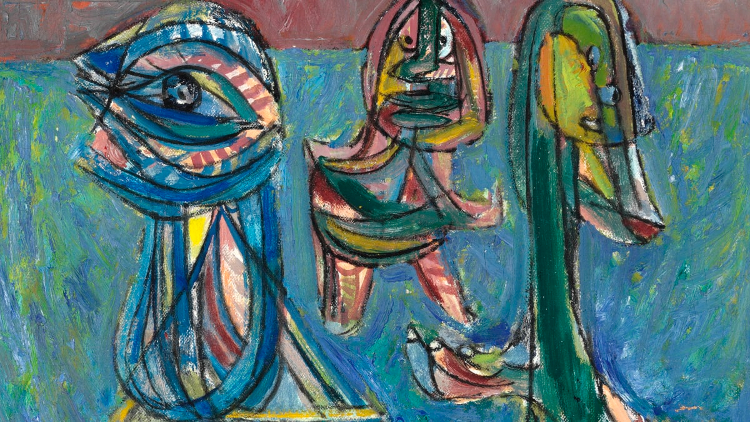Art born out of adversity

This December, the auction house Bruun Rasmussen Auctioneers, together with the Swedish auction house Bukowskis and auction house British Bonhams, will host a magnificent CoBrA Live Auction in Copenhagen, Denmark’s capital.
At the auction a wide selection of works from a large number of artists related to CoBrA by the movement’s prominent artists such as Asger Jorn, Karel Appel, Pierre Alechinsky, Egill Jacobsen, Carl-Henning Pedersen and Sonja Ferlov Mancoba.
In the autumn of 1948, a small group of artists from Denmark, Belgium and the Netherlands, who all shared the same thoughts on the role of art in society, met at the Hotel Notre Dame café in Paris. This became the starting point for one of the most ground-breaking and innovative art movements of the 20th century: CoBrA.
On 6 December, Bruun Rasmussen Auctioneers opens the doors in Copenhagen for a spectacular CoBrA auction together with Bukowskis and Bonhams.
The auction celebrates the creativity, community, spontaneity and experimental approach to art, which were the core slogans of CoBrA.
A Global Collaboration
The CoBrA auction is the result of a close collaboration between Bruun Rasmussen, Bukowskis and Bonhams in the new global network of auction houses under Bonhams’ wings.
The works in the auction are currently being shown in different European cities in a travelling exhibition, which concludes in Copenhagen, where everyone can stop by and see the works up for auction between 24 and 28 November.
“All the big names of the CoBrA movement are represented at our upcoming auction, and the travelling exhibition, which began in Paris, where the movement started in 1948, is a strong symbol of our European network and cooperation. We are therefore looking forward to this fantastic opportunity to present these paintings to European collectors,” says Niels Raben, Head of Modern & Contemporary Art at Bruun Rasmussen.
Powerful Voices of Post-war Europe
The CoBrA movement was formed in 1948 by a group of artists of different nationalities. This included names such as Asger Jorn, Christian Dotremont, Karel Appel and Corneille, who all shared the same auction in society.
The name CoBrA comes from the first letters in the names of the hometowns of the artists involved: Copenhagen, Brussels and Amsterdam.
After the horrors of two world wars, CoBrA’s ideology emerged as a desire to reform society, transcend the norms and create a better world for humanity to thrive in.
The artists wanted to start over, and all previously held truths had to be broken down in an attempt to create a universal idiom, which could unite a war-torn Europe.
They did away with the perception of the artist as an isolated genius – the artist should instead be an active part of society and create art that could influence people to move in a new and better direction. In this way art was seen as a facilitator for change.
An Artistic Revolution
It was through the unconscious, the imaginative and the spontaneous that the artists found their way to the new, unspoiled and liberated art form they sought.
They drew on inspiration from children’s drawings, mythologies and primitive folk art, and virtually every conceivable medium was used – from paintings, sculptures and ceramics to prints and poetry.
Recurring features across the works of the group were strong colours, strange bird creatures and figures that uneasily and insistently twist and turn in front of us viewers.
On paper, the group was only active from the end of 1948 until 1951, but the spontaneous and expressive approach to art defines the work of many artists across several decades and resonated far beyond the borders of Europe.
Art in Times of Adversity
CoBrA grew out of two world wars, where a sense of balance at the global level had to be restored and the wounds healed.
It was the sense of confinement and the accumulated longing for new sceneries following the war that blew the lid off the energy and imagination of an approach to art that transcended all boundaries.
It was once again possible to travel freely and collaborate on developing dreams and formulating visions for a new world. CoBrA artists were connected, and they became the guarantors of an artistic revolution in Europe.
Today, works by artists related to CoBrA are still in high demand – this is happening at a time when the world is faced with adversity with new crises in new formats and sizes, and where life can seem uncertain with a rising need for bringing people together and finding common ground.
Art can once again become a mouthpiece to get over, or through, a crisis when it hits. CoBrA’s colourful energy burst is thus eternally topical and reminds us that art, mobility, peace and freedom are privileges that we cannot take for granted.
Record Hammer Price for a CoBrA Painting
The highest hammer price for a CoBrA work within the Bonhams network of auction houses was achieved back in 2006 at Bruun Rasmussen Auctioneers in Copenhagen.
The work was one of Asger Jorn’s monumental masterpieces – the colourful oil painting “Tristesse blanche” from 1958. The hammer price was DKK 8.3 million / EUR 1.1 million (including buyer’s premium).
The CoBrA auction will take place on 6 December at Bredgade 33 in Copenhagen thanks to a close collaboration between Bruun Rasmussen Auctioneers, Bukowskis and Bonhams Cornette de Saint Cyr.
Bonhams’ Global Network
Bruun Rasmussen has now been part of Bonhams for more than half a year.
The auction house work closely with art specialists from other auction houses, share knowledge and promote the art objects at the auctions in places around the world where it makes the most sense for the auction lot and the customers.
The collaboration has been rewarding in every way, and Bruun Rasmussen look forward to the continued journey together with Bonhams’ global network.

